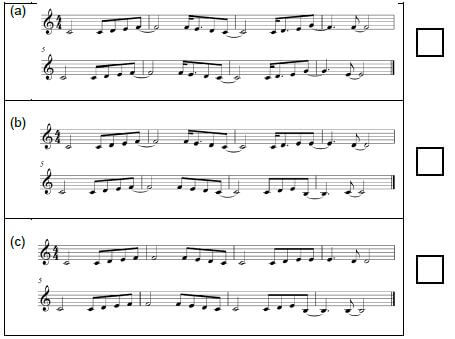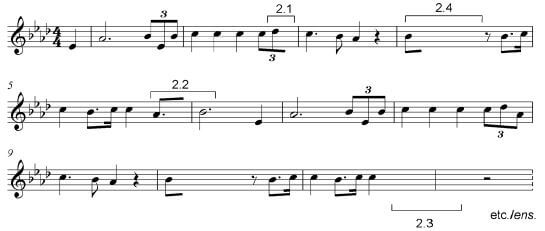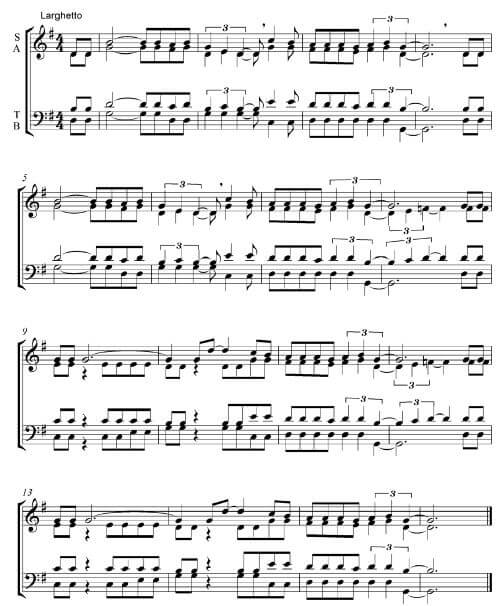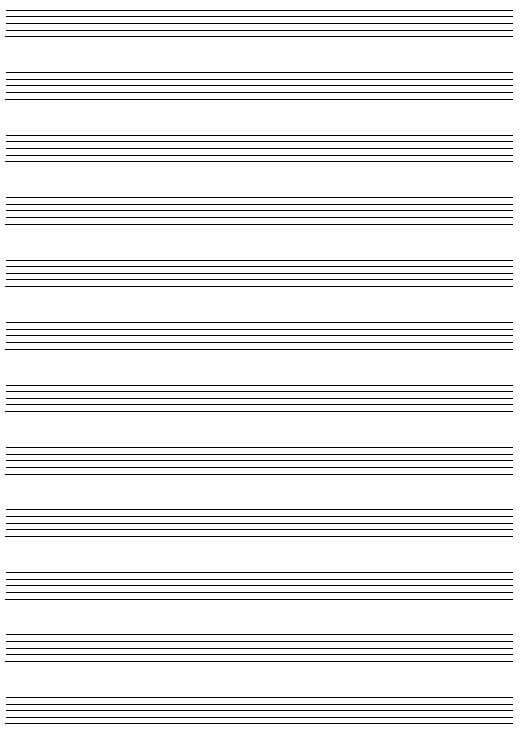MUSIC PAPER 2 GRADE 12 QUESTIONS - NSC EXAMS PAST PAPERS AND MEMOS NOVEMBER 2018
Share via Whatsapp Join our WhatsApp Group Join our Telegram GroupMUSIC
PAPER 2
GRADE 12
NSC EXAMS
PAST PAPERS AND MEMOS NOVEMBER 2018
INSTRUCTIONS AND INFORMATION
- This question paper consists of THREE sections:
SECTION A: Aural (10)
SECTION B: Recognition (12)
SECTION C: Form (8) - QUESTION 1, QUESTION 2, QUESTION 3 and QUESTION 7 are COMPULSORY.
- Answer QUESTION 4 (Western Art Music (WAM)) OR QUESTION 5 (JAZZ) OR QUESTION 6 (Indigenous African Music (IAM)).
- Write ALL your answers on this question paper. Use a pencil for music notation and blue or black ink for the other answers.
- This examination will be conducted while the candidates are listening to a CD. 6.
- The music teacher of the centre must conduct the examination in the presence of the invigilator.
- The last page of this question paper is manuscript paper intended for rough work. The candidate must NOT remove this page.
- Candidates may NOT have access to any musical instrument for the duration of this examination.
- Candidates must take note of the mark allocation of each question to provide enough information in their answers.
- Write neatly and legibly.
INSTRUCTIONS FOR THE PERSON OPERATING THE SOUND EQUIPMENT
|
QUESTIONS
SECTION A: AURAL
QUESTION 1
Play Track 1 TWICE in succession. |
1.1 Listen to the melodic and rhythmic phrase. Notate the rhythm of the missing notes in bars 2–3 below.
(3)
Play Track 1 TWICE again. |
Play Track 2 THREE times in succession. |
1.2 Which ONE of the notations below best represents the solo voice part? Make a cross (X) in the appropriate block.  (1) [4]
(1) [4]
Play Track 2 ONCE more. |
QUESTION 2
Play Track 3 ONCE to provide a general overview. |
Listen to the extract below. Answer the questions that follow. 
Play Track 4 TWICE. |
2.1 Name the interval formed between the Db note and the missing note in bar 24. (1)
Play Track 5 TWICE. |
2.2 Which type of non-chordal note do you hear in bar 54? __________________________________________________________ (1)
2.3 Name the cadence at bars 11 to 12. __________________________________________________________ (1)
Play Track 6 THREE times. |
2.4 Listen to the music from bars 1 to 6. Some of the notation in bar 4 has been omitted from the score. Fill in the missing pitches and note values that correspond with the music that you hear. (2)
2.5 Name the solo instrument that plays the melody line in this extract. __________________________________________________________ (1) [6]
TOTAL SECTION A: 10
SECTION B: RECOGNITION OF MUSIC CONCEPTS
QUESTION 3: GENERAL LISTENING (COMPULSORY)
Listen to the following tracks and answer the questions that follow.
Play Track 7 THREE times. |
3.1 With which items in COLUMN A do you associate the music that you hear in Track 7? Make a cross (X) in THREE appropriate blocks. (3)
COLUMN A | Track 7 |
Chromatic passage | |
Adagio | |
Duet | |
Allegretto | |
String and wind quartet | |
Major key | |
String quartet |
Play Track 8 TWICE. |
3.2 Which ONE of the following statements is CORRECT? Make a cross (X) in the appropriate block. (1)
STATEMENT | |
The extract consists of a motif, an imitation and an imperfect cadence | |
The extract consists of a motif, inversion and an imperfect cadence | |
The extract consists of a motif, repetition and an imperfect cadence |
Play Track 9 THREE times. |
3.3 With which items in COLUMN A do you associate the music that you hear in Track 9? Make a cross (X) in THREE appropriate blocks. (3)
COLUMN A | Track 9 |
Vocal melody starts with anacrusis | |
Triple time | |
Quadruple time | |
Swing/shuffle rhythm | |
Guitar introduction | |
12-bar blues | |
Syllabic word setting |
Play Track 10 THREE times. |
3.4 With which items in COLUMN A do you associate the music that you hear in Track 10? Make a cross (X) in THREE appropriate blocks. (3)
COLUMN A | Track 10 |
Chordal accompaniment | |
Allegro | |
Simple quadruple | |
Compound triple | |
Guitar introduction | |
Straight rhythm | |
Alto voice |
Play Track 11 TWICE. |
3.5 Choose any TWO items from COLUMN A and identify what you hear in COLUMN B. (2)
COLUMN A | COLUMN B(IDENTIFY) |
Solo instrument | |
Prominent compositional technique | |
Musical genre | |
Texture |
(12 ÷ 3) [4]
Answer QUESTION 4 (WAM) OR QUESTION 5 (JAZZ) OR QUESTION 6 (IAM).
QUESTION 4: WAM
Play Tracks 12, 13 and 14 TWICE. |
4.1 Listen to the extracts and answer the questions.
With which ONE of the characters in COLUMN A do you associate EACH track? Make a cross (X) in the appropriate block for each track. (3)
COLUMN A | Track 12 | Track 13 | Track 14 |
Papageno | |||
Tamino | |||
Sarastro | |||
Monastatos | |||
Pamina |
Play Track 15 TWICE. |
4.2 Give a suitable Italian term to describe the tempo of the music in this extract. __________________________________________________________ (1)
4.3 Name the wind instrument heard at the end of this extract. __________________________________________________________ (1)
Play Track 16 TWICE. |
4.4 Which item describes the compositional technique used in this extract? Choose from the list below. Make a cross (X) in the appropriate block. (1)
Melodic inversion | Descending sequence | Rhythmic variation | Ascending sequence |
Play Track 17 TWICE. |
4.5 What is the title of the movement from which this extract is taken? __________________________________________________________ (1)
Play Track 18 THREE times. |
4.6 Which solo wind instrument plays the melody? __________________________________________________________ (1)
4.7 Which wind instrument plays an accompaniment to this melody at the start of this extract? __________________________________________________________ (1)
4.8 Describe how Beethoven employs the string section in this extract. __________________________________________________________ (2)
Play Track 19 THREE times. |
4.9 Choose THREE statements below that best describe the music that you hear. Make a cross (X) in THREE appropriate blocks. (3)
All instruments play in unison | |
Ascending legato passages | |
Ascending chromatic scale passages | |
Ascending chromatic sequences in clarinets | |
Long sustained note | |
Clarinet solo |
4.10 Write down the title of the work from which this extract is taken. _____________________________________________________ (1)
Play Track 20 TWICE. |
4.11 Identify from which part of the work this extract is taken. Choose from the list below and make a cross (X) in the appropriate block. (1)
Part of work | Answer |
First subject/theme | |
Second subject/theme | |
End of the development | |
Beginning of the coda |
OR
(16 ÷ 2) [8]
TOTAL SECTION B: 12
QUESTION 5: JAZZ
Play Track 21 TWICE. |
5.1 With which FOUR items in COLUMN A do you associate the music that you hear? Make a cross (X) in FOUR appropriate blocks. (4)
COLUMN A | Answers |
Mbaqanga | |
Pentatonic | |
Major | |
Simple quadruple | |
12-bar blues | |
Cape jazz | |
| |
Kwela | |
Harmonic chord cycle |
Play Track 22 TWICE. |
5.2 Which item describes the melodic movement of the horn section? Make a cross (X) in the appropriate block. (1)
Chromatic passage | |
Group improvisation | |
Ascending sequences | |
Descending sequences |
Play Track 23 TWICE. |
5.3 Apart from the drum kit, name ONE other instrument that forms part of the rhythm section in this extract. __________________________________________________________ (1)
Play Track 24 THREE times |
5.4 With which ONE of the South African solo artists below do you associate this extract? Make a cross (X) in the appropriate block. (1)
Robbie Jansen | Philip Tabane | Zim Ngqawana | Hugh Masekela |
5.5 With which THREE items in COLUMN A do you associate the music that you hear? Make a cross (X) in THREE appropriate blocks. (3)
COLUMN A | Answers |
Fuses Xhosa songs with blues | |
Abdullah Ibrahim influences | |
Idiophone | |
Modal chord progression | |
Improvisation | |
Ceremonial atmosphere |
5.6 Describe the role of the piano in this extract. (2)
Play Track 25 THREE times. |
5.7 Name the instrument that plays the accompaniment in the introduction of this extract. __________________________________________________________ (1)
5.8 Describe the role of the backing singers. (2)
5.9 Name ONE group that you associate with this jazz style. ______________________________________________________________ (1)
(16 ÷ 2) [8]
TOTAL SECTION B: 12
OR
QUESTION 6: IAM
Play Track 26 TWICE. |
6.1 With which FOUR items in COLUMN A do you associate the music that you hear? Make a cross (X) in FOUR appropriate blocks. (4)
COLUMN A | Answers |
Mbaqanga | |
Modal | |
Malombo | |
Umrhube | |
Ululation | |
Major | |
Aerophone | |
Concertina | |
Repetition |
Play Track 27 TWICE. |
6.2 Describe the whistling that you hear. (1)
6.3 Write down a suitable term to describe the rhythmic feature in the accompaniment. (1)
Play Track 28 TWICE. |
6.4 With which THREE items in COLUMN A do you associate the music that you hear? Make a cross (X) in THREE appropriate blocks. (3)
COLUMN A | Answers |
Blues | |
Batswana | |
Idiophone | |
Malombo drum | |
Chord cycle | |
Tshikona |
Play Tracks 29 and 30 TWICE in succession. |
6.5 Identify the differences between Track 29 and Track 30. Choose only TWO items in column A for your comparison. (4)
COLUMN A | Track 29 | Track 30 |
Introduction | ||
Voice type | ||
Tempo/Beat |
6.6 Name the style that you associate with both extracts. (1)
6.7 With which artists/bands do you associate EACH track?
Answer:
Track 29: ___________________________________________________
Track 30: ___________________________________________________ (2)
(16 ÷ 2) [8]
TOTAL SECTION B: 12
SECTION C: FORM
QUESTION 7
Read and study the questions for ONE minute.
Play Track 31 ONCE to provide an overview. |
Listen to the piece below while you study the score.
Play Track 31 again. |
7.1 Name the form type of this piece. ______________________________________________________________ (1)
7.2 Motivate your answer to QUESTION 7.1 by giving a schematic layout of the form of this piece. Use the table below. (4)
Section | Bar numbers |
7.3 Name the texture type of this extract. ______________________________________________________________ (1)
7.4 What is the function of the F natural in bar 8? ______________________________________________________________ (1)
7.5 Which ONE of the following features is used in this piece? Make a cross (X) in the appropriate block. (1) [8]
Pentatonic scale | Triple metre | Syncopation | Children’s choir |
Play Track 31 for a final overview. |
TOTAL SECTION C: 8
GRAND TOTAL: 30
